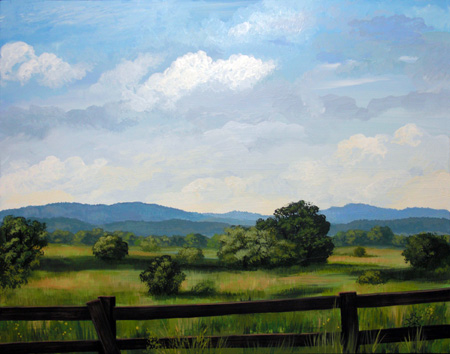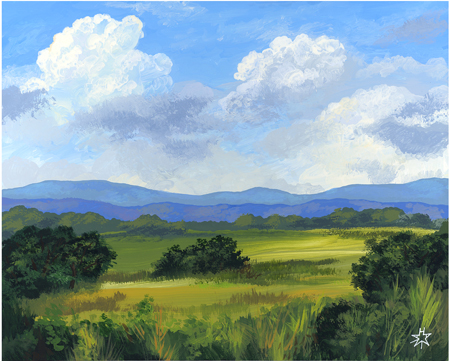My weblog ELECTRON BLUE, which concentrated on science and mathematics, ran from 2004-2008. This weblog, which is more art-oriented, is its successor. Please visit the archives of ELECTRON BLUE using the link to the right.
A Quiet Place in Virginia

Here is another version of the Blue Ridge scene I posted on August 8. This one is also acrylic on masonite, but slightly larger than the earlier one at 14" x 11". It's called "A Quiet Place." I hope to do a number of these Virginia country scenes, some with buildings and cattle and some without, and market them in upscale country and resort restaurants. Another possibility is small town tourist galleries, though there is a lot of this kind of art out there and I would have to choose carefully. I like painting these scenes because it is peaceful. I may keep a few of them for myself so that I can remember summer as it should be, not as it is for me in the city.
For the painters who might be reading this, here are some technical notes about this piece. I created a background under layer on pre-primed Masonite with colored gessos by Matisse Derivan, an excellent Australian supplier. These gessos are already in realistic landscape colors and the white can be tinted with whatever other color you need, in my case sky blue. I also added the lighter greens and golds for the field in this medium.
When the background colors were dry, I added in details of clouds with "regular" acrylic paint, from various different suppliers such as Matisse, Liquitex, and Winsor Newton Finity. After that was dry, I added in a flat layer for the mountains, again in the Matisse gesso. The idea is to get the basic color down in the colored gesso so that the area is covered, and then work over the dry background in semi-transparent acrylic. This solves a constant problem with acrylic, namely that most acrylic paints do not cover and have to be re-painted two or more times to get opacity.
The rest of the landscape was done in regular acrylic, using chrome green as the basic color and different versions of "Naples Yellow Hue" to vary the lightness. The darkest tree shadows were done by mixing black and dark blue (ultramarine) into the chrome green. Chrome green is a great landscape color because it is opaque. It is one of the few acrylic colors where you get results on the first coating. This is the color that the French landscapist Camille Corot used to create his ideal-real images. Unfortunately, back in the 19th century, chrome green was not a stable color and it oxidised to greyish black. I don't pretend to compare myself to Corot or even imitate him, but at least my modern chrome green won't fade. I finished the picture by adding in the fence with more opaque gesso acrylic and mellowing the color with a transparent acrylic burnt umber glaze. Lots more to follow in this series, I hope.
Posted at 9:29 pm | link
Blue Ridge Vista

I just finished the first of my new set of Virginia countryside paintings. This month I plan to do a series of them based on my travels in the Shenandoah valley. This piece is acrylic on Masonite, 10" x 8". It is small because it is a test of my color matching and sky painting strategies. The others will be larger. I want to convey a feeling of summer serenity with these images.
When I exhibit them, I need an "artist's statement." This is what I composed as explanatory text for this series:
"I think of the Virginia countryside as a landscape in perfect proportion. There are the distant hills in the blue of atmospheric perspective, then the closer hills in dark green, and then the radiant green of fields and vegetation closer to the viewer. I also love the endlessly changing light, color shades, and forms of clouds, in fair or stormy weather. This landscape is beautiful in all four seasons. I also like to include traditional architecture in my country scenes, because I love the geometry and textures of farm buildings. In these paintings and sketches, I try to convey the colors and feeling of a moment in time. In nature, the scene will change in the next minute but by the power of art, it will be captured, saved, and preserved in the viewer's memory."
Posted at 8:29 pm | link
